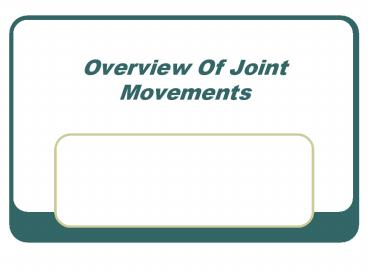Overview Of Joint Movements - PowerPoint PPT Presentation
1 / 30
Title:
Overview Of Joint Movements
Description:
Examples are synarthroses or joints that do not move. United by dense, ... For example, in doing a chin up, the same muscles are working but the forearm is ... – PowerPoint PPT presentation
Number of Views:79
Avg rating:3.0/5.0
Title: Overview Of Joint Movements
1
Overview Of Joint Movements
2
Joints Are Articulations
- One bone articulating with another
- Not all joints are created equally
- Three major categories
- Fibrous, Cartilaginous, and Synovial
- examples
3
Fibrous Joints
- Examples are synarthroses or joints that do not
move - United by dense, fibrous connective tissue
- E.g., sutures of the skull
4
Cartilaginous Joints
- Amphiarthroses, joints that move slightly
- Characterized by no joint capsule
- Held together by cartilage
- Generally contain a fibrocartilaginous disc
- Motion limited
- E.G., intervertebral discs
- Pubic symphysis
5
Synovial Joints
- Freely Moveable
- Motion dictated by the shape of the bones in the
joint and by supporting soft tissue, e.g., muscle
attachments and joint capsules (ligaments) - Movements are described traditionally by the
actual direction the bones move, called
Osteokinematic Motion and the axis about which
they move
6
Fibrous Joints
7
Cartilaginous Joints
8
Synovial Joint
9
Synovial Joints
10
Synovial Joints
11
Anatomical Position
12
Planes
13
Synovial Joints
14
Synovial Joints
15
Synovial Joints
16
Synovial Joints
- Flexion/Extension movement in the sagittal
plane about a frontal axis - Abduction/Adduction movement in the frontal
plane about a sagittal (A-P) axis - Internal/External Rotation movement in the
transverse plane about a longitudinal axis - Out of True Plane
17
Movements
18
Movements
19
Movement
20
Directional Terms
21
Directional Terms
22
Synovial Joints
- Joints that move in one plane are called uniaxial
and are said to allow one degree of freedom
i.e., IP joints of fingers, humero-ulnar - Two plane joints are biaxial with two degrees of
freedom i.e., MP joint in hand - Three plane joints are multiaxial with three
degrees of freedom i.e, glenohumeral joint
23
Types of Synovial Joints
- Hinge uniaxial 1 degree of freedom IP
- Condyloid/ellipsoid 2 DOF MP, Radiocarpal
- Ball in socket 3 DOF glenohumeral, hip
- Gliding or plane small, 3 DOF limited ROM but
in all directions a-c joint, intercarpals,
facet joints of spine - Saddle rare, 3 DOF carpometacarpal joint of
the thumb - Pivot 1 DOF rotation atlas/axis superior
and inferior radio-ulnar
24
Directional Terms
25
Synovial Joints
- We must consider the movement within the joint
itself as it may be different than that of the
bone (the osteokinematic) - This type of motion is called Arthrokinematic,
meaning the motion of the joint - E.G., the glenohumeral joint as one flexes or
abducts the joint, the head of the humerus will
glide inferiorly in the glenoid fossa
26
Synovial Joints
- All joints that move are technically called
rotary as one bone in some way will rotate on
another - The moving bone rotates about an imaginary axis
called the joint axis - The resulting motion of the large bone is the
osteokinematic motion we described - We refer to the linkage of joints as a kinematic
chain. When the end of the chain is against an
object, the chain is closed - When it is not opposed by the ground or an object
is open - Example, using the quads to 1) squat or 2) extend
in free space
27
Moving the joints
- Active motion is produced by muscle contractions
- Muscles can move the same joint in a variety of
ways depending on what is being stabilized - Normally, we describe a muscles functions based
upon its insertion moving towards the origin when
contraction takes place e.g., elbow flexion - Muscle can work in reverse if the distal end is
fixed. For example, in doing a chin up, the same
muscles are working but the forearm is fixed or
held steady and the origin of the elbow flexors
moves towards insertion called Reverse Action
28
Moving the joints
- During normal muscle contractions, the muscle
fibers shorten during the activity called
concentric - If a muscle lengthens during the contraction as
when you perform a squat, is called eccentric
(sometimes called negative) - Generally, eccentric contractions are antigravity
- Another example the back muscles when you bend
forward
29
Moving the joints
- Muscles may be uni, bi or multiarticular
depending on how many joints they cross from
their origin to insertion - Remember that if a muscle or its tendon passes
over a joint it has to act on it unless somehow
stabilized not to do so - Example, biceps brachii, flexor digitorum
superficialis, rectus femoris and so on - Muscles CAN NOT act maximally over all joints at
same time become insufficient.
30
End Points
- When a joint, under normal circumstances, can go
no further in its motion, it is said to have
reached its End Point - Soft
- Hard
- Pathological































